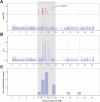Identification of a candidate sex determination region and sex-specific molecular markers based on whole-genome re‑sequencing in the sea star Asterias amurensis
- PMID: 39792457
- PMCID: PMC11757944
- DOI: 10.1093/dnares/dsaf003
Identification of a candidate sex determination region and sex-specific molecular markers based on whole-genome re‑sequencing in the sea star Asterias amurensis
Abstract
Sex determination systems are diverse in echinoderms, however, our understanding is still very limited in this research field, especially for Asteroidea species. The northern Pacific seastar, Asterias amurensis, has attracted widespread concern due to its population outbreaks and high-risk invasions. Using whole-genome re-sequencing data from 40 females and 40 males, we identified a candidate sex determination region in A. amurensis. Based on the distribution characteristics of 525 sex-associated single nucleotide polymorphisms, identified by GWAS analysis, 119 sex-specific loci were isolated combining a custom Perl script, PCA analysis, and the selection signatures of fixation index FST, suggesting that a 7-12 Mb region on chromosome 10 is a candidate sex-determining region. The existence of female-specific sequences and the genotypes of sex-specific loci indicated that A. amurensis might utilize a ZZ/ZW sex-determination system. We also developed two pairs of sex-specific primers that could distinguish the genetic sex of this starfish with 100% accuracy. As the first study on sex determination in Asteroidea, it will provide novel insights into diverse sex determination systems in echinoderms and allow for in-depth studies on sex-related eco-physiological issues in A. amurensis.
Keywords: GWAS; sex determination; sex-specific markers; starfish; whole-genome re-sequencing.
© The Author(s) 2025. Published by Oxford University Press on behalf of Kazusa DNA Research Institute.
Conflict of interest statement
The authors declare no conflict of interest.
Figures






Similar articles
-
High-quality chromosome-level genome assembly of the Northern Pacific sea star Asterias amurensis.DNA Res. 2024 Apr 1;31(2):dsae007. doi: 10.1093/dnares/dsae007. DNA Res. 2024. PMID: 38416146 Free PMC article.
-
Chromosome-level genome assembly of the northern Pacific seastar Asterias amurensis.Sci Data. 2023 Nov 4;10(1):767. doi: 10.1038/s41597-023-02688-w. Sci Data. 2023. PMID: 37925473 Free PMC article.
-
Identification of sex determination locus in sea cucumber Apostichopus japonicus using genome-wide association study.BMC Genomics. 2022 May 23;23(1):391. doi: 10.1186/s12864-022-08632-3. BMC Genomics. 2022. PMID: 35606723 Free PMC article.
-
Advances and perspectives on the research of starfish outbreaks in northern China.Ying Yong Sheng Tai Xue Bao. 2023 Apr;34(4):1146-1152. doi: 10.13287/j.1001-9332.202304.031. Ying Yong Sheng Tai Xue Bao. 2023. PMID: 37078336 English.
-
Research Progress on Starfish Outbreaks and Their Prevention and Utilization: Lessons from Northern China.Biology (Basel). 2024 Jul 17;13(7):537. doi: 10.3390/biology13070537. Biology (Basel). 2024. PMID: 39056729 Free PMC article. Review.
References
-
- Dupont S, Thorndyke M.. Bridging the regeneration gap: insights from echinoderm models. Nat Rev Genet. 2007:8:320–320. https://doi.org/10.1038/nrg1923-c1 - DOI
-
- Byrne M, Morrice MG, Wolf B.. Introduction of the Northern Pacific asteroid Asterias amurensis to Tasmania: reproduction and current distribution. Mar Biol. 1997:127:673–685. https://doi.org/10.1007/s002270050058 - DOI
-
- Nishimura H, Miyoshi K, Chiba S.. Predatory behavior of the sea stars Asterias amurensis and Distolasterias nipon on the Japanese scallop, Mizuhopecten yessoensis. Plankton Benthos Res. 2019:14:1–7. https://doi.org/10.3800/pbr.14.1 - DOI
-
- Li L, Yu Y, Wu W, Wang P.. Extraction, characterization and osteogenic activity of a type I collagen from starfish (Asterias amurensis). Mar Drugs. 2023:21:274. https://doi.org/10.3390/md21050274 - DOI - PMC - PubMed
-
- Ling SD, et al.Hotspots of exotic free‐spawning sex: man‐made environment facilitates success of an invasive seastar. J Appl Ecol. 2012:49:733–741. https://doi.org/10.1111/j.1365-2664.2012.02133.x - DOI
MeSH terms
Substances
Grants and funding
LinkOut - more resources
Full Text Sources
Research Materials
Miscellaneous

